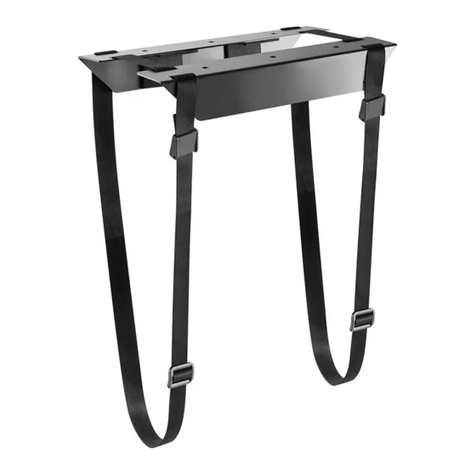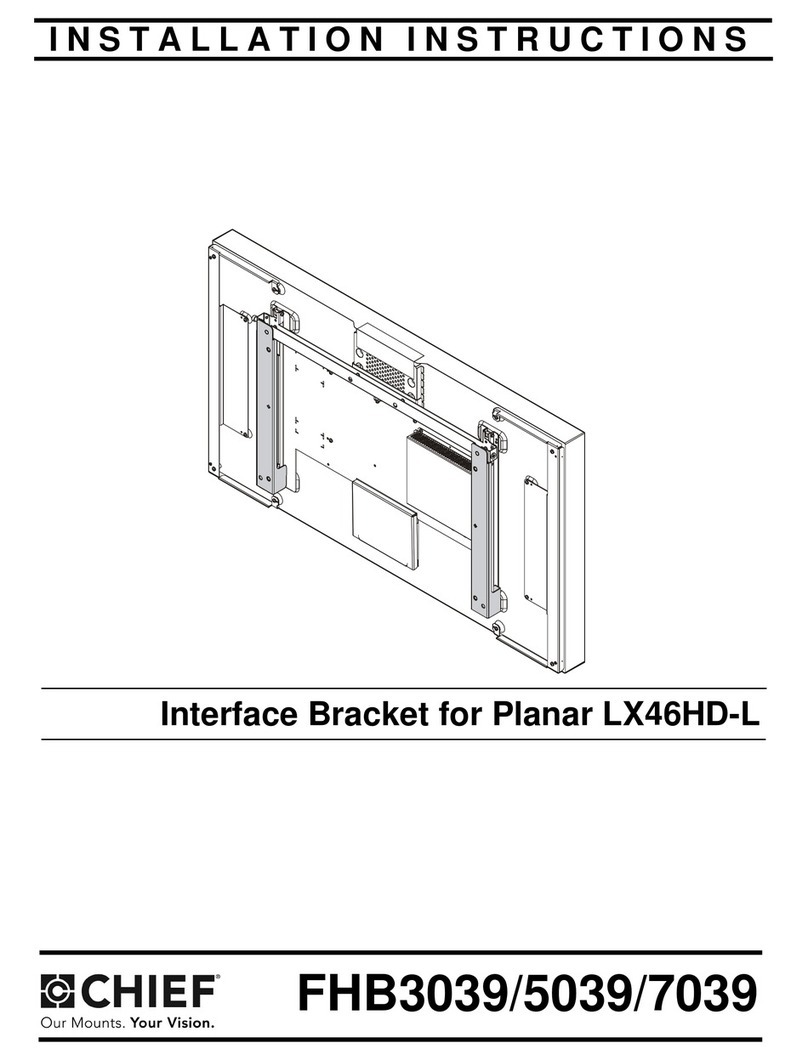König & Meyer 12330 User manual

12330 Orchester-
Dirigentenpult Unterteil
- Hochwertiges Unterteil zur Kombination mit verschiedenen Orchester-
-Dirigentenpultplatten
- Standsicher und stabil durch:
-schweren und dabei stylischen 3-Punkt-Sockel aus Stahl sowie
-besonders starker Rohrkombination 42/35 mm
- Das Auszugrohr ist fein gestuft höhenverstellbar und doppelt gesichert
- Daten: Höhe 840, 880, ... 1360, 1400 mm, Fußkreis ø 700 mm, Gewicht 8,1 kg
- Passend für die K&M Orchester-Dirigentenpultplatten und Partiturablagen
-13232 bis 12338
SICHERHEITSHINWEISE
Vielen Dank, dass Sie sich für dieses Produkt entschieden haben. Diese Anleitung informiert Sie
über alle wichtigen Schritte bei Aufbau und Handhabung. Wir empfehlen, sie auch für den späteren
Gebrauch aufzubewahren.
- Aufmerksame Handhabung erforderlich, da die Verstellmöglichkeiten
-Einklemmgefahren bergen
- Der Untergrund muss geeignet, d.h. eben und tragfähig sein.
- Bauteile (Sockel, Rohrkombination) nicht fallen lassen
- Die drei Schraubverbindungen zwischen Stativrohr und Sockelplatte
-müssen stets bis zum Anschlag fest angezogen sein 2.1
- Nach abgeschlossener Höhenverstellung muss sich die Klinke 4.4 im
-Eingriff befinden und die Klemmschraube 4.5 fest angezogen sein.
- Vor und nach Benutzung ist eine Sicht- u. Funktionsprüfung vorzunehmen,
-ob alle Bestandteile vorhanden und soweit erkennbar in Ordnung sind.
- Beschädigte Stative dürfen entweder nicht weiter eingesetzt bzw. sie
-müssen zuvor einer qualifizierten Reparatur unterzogen werden.
- Verwendung nur im Innenbereich
2. STATIV
3. ORCHESTER-DIRIGENTENPULTPLATTEN
1. BESTANDTEILE
AUFSTELLANLEITUNG
1. BESTANDTEILE (a-e)
aSockel - bRohrkombination - cSechskantschraube M6 x 22 mm
dU-Scheibe ø 6,4 mm - eSchlüssel SW10/SW13
2./3. MONTAGE
2. STATIV
2.1 Sockelplatte aans Grundrohr b.1 halten und beide mittels der drei
2.1 Sechskantschrauben M6 x 20 mm cund U-Scheiben ø 6,4 mm dfest
2.1 verschrauben. Dazu Schlüssel SW10 ebenutzen.
2.2 Stativ nun aufrichten und vorsichtig auf dem Boden abstellen. Zum Schutz
2.2 des Bodens ruht die Sockelplatte aauf 3 Standfüßen mit Filzauflage.
2.2 Gelockerte Standfüße mit einem Steckschlüssel (SW8=M5) wieder anziehen.
3. ORCHESTER-DIRIGENTENPULTPLATTEN
3.1.a
Art-Nr. 12332
buche natur
3.1.b
Art-Nr. 12333
buche schwarz
3.2.a
Art-Nr. 12334
buche natur
Doppelleiste
3.2.b
Art-Nr. 12335
buche schwarz
Doppelleiste
3.3
Art-Nr. 12338
buche schwarz
ausziehbar
3.4 Die Platten verfügen jeweils über 4 Schraubensätze, bestehend aus:
3.4 1. Schloßschraube M5 x 20 mm - 2. Sicherungsmutter M5
3.4 3. Schlüssel SW8/SW13 - 4. Schutzkappe SW8
3.5 a. Schloßschrauben in alle 4 Bohrungen der Dirigentenpultplatte drücken;
3.5 b. diese durch die Gelenkplatte b.5 stecken und...
3.5 c. ...jeweils mit der Sicherungsmutter verschrauben.
3.5 d. Abschließend Schutzkappen aufdrücken.

KÖNIG & MEYER GmbH & Co. KG
Kiesweg 2, 97877 Wertheim, www.k-m.de
12330-000-55 Rev.05 03-80-594-00 6/18
TECHNISCHE DATEN
Material
Sockel, Rohre, Haken, Gelenk: Stahl, gepulvert
Gewinde: Stahl, verzinkt
Schelle, Schalen, Kappen, Griffe: PA-6
Parkettschoner: Filzronde ø 25 x 3,5 mm (3x)
Maße
Sockel: Fußkreis ø 700 mm, t = 8 mm
Rohrkombination.: ø 42 / ø 35 mm
Höhe: 840-1400 mm (Auflage unten, siehe Abb. 7.a)
Neigungswinkel: 10° (annährend senkrecht)
Neigungswinkel: bis 90° (waagerecht)
Karton Rohrkombination: 940 x 120 x 120 mm
Sockel: 660 x 660 x 50 mm
Gewicht 8,1 kg
Zubehör
Orchester-Dirigentenpultplatten (siehe Kap.3):
12332 / 12333 - 12334 / 12335 - 12338
Partiturablagen: 12336 / 12337
4. AUSZUGROHR
4. AUSFAHREN
5. AUSZUGROHR EINFAHREN
6. NEIGUNGSWINKEL EINSTELLEN
7. ABMESSUNGEN
Abb.: 7.a
Platte 12332/33,
Auflage unten,
45° geneigt
INSTANDHALTEN, REINIGEN
- Schonender Umgang mit dem Stativ erhält
-die Teleskopierbarkeit, die Tragkraft und
-die Sicherheit der Installation
- Bei Wartungsarbeiten -stets im unbelasteten
-Zustand- auf mögliche Gefährdungen achten
-(Einklemmen, Anstoßen, Kippen)
- Zur Reinigung und Pflege ein leicht feuchtes
-Tuch und ein nicht scheuerndes
-Reinigungsmittel benutzen
FEHLERSUCHE (F) und BESEITIGUNG (B)
F: Stativ kippelt bzw. steht schief:
F: B: Untergrund auf Ebenheit prüfen
F: B: Sockelplatte auf Ebenheit prüfen
F: B: Festsitz der Schrauben can Sockel aund
F: B: Grundrohr b.1 prüfen und ggf. nachziehen
F: Auszugrohr b.3 fährt ungewollt ein:
F: B: Klapphaken in Aussparung drücken
F: B: und Flügelmutter festziehen 4.3-4.5
F: Dirigentenpultplatte Kap.3 neigt sich ungewollt:
F: B: Verschraubung am Gelenk festziehen 6.3
BENUTZERHINWEISE und FUNKTIONEN
Das Dirigentenpult ist vielseitig verstellbar in
Neigung und Höhe.
4./5. HÖHE (14 Stufen á 40 mm)
Die eingestellte Höhe ist gleich doppelt gesichert.
4. AUSZUGROHR AUSFAHREN
4.1 Flügelmutter der Spannschelle b.2 etwas lösen
4.2 Auszug b.3 in gewünschte Höhe schieben, wobei
4.2 der Fanghaken ohne Zutun automatisch entriegelt
4.2 wird und auch nicht wieder von selbst einrastet.
4.3 Der Fanghaken muss vom Bediener aktiv in die
4.3 gewünschte Aussparung gedrückt werden.
4.4 Sobald der Haken eingetaucht ist, wird das Rohr
4.4 um 2 mm abgesenkt, wodurch der Fanghaken
4.4 gegen ungewolltes Ausrasten gesichert ist.
4.5 Flügelmutter wieder festziehen
5. AUSZUGROHR EINFAHREN
5.1 Flügelmutter der Spannschelle b.2 etwas lösen
5.2 Zunächst Auszugrohr b.3 etwas anheben, wodurch
5.2 der Klapphaken automatisch entriegelt wird.
5.3 Anschließend Auszugrohr einfahren lassen und...
5.4 ...Fanghaken wieder in die vorgesehene Öffnung
5.4 drücken und in das Rohr einhaken lassen
5.5 Flügelmutter wieder festziehen
6. NEIGUNG (10° - 90°)
Die Platte kann stufenlos eingestellt werden von:
90° = waagerechter Position in...
10° = ...annähernd senkrechte Lage. Die Begrenzung
10° = schützt die Notenblätter vor dem Herabfallen.
6.1 Klemmgriff lösen
6.2 Notenpultplatte in gewünschte Position schwenken
6.3 Klemmgriff wieder festziehen
7. ABMESSUNGEN

12330 Orchestra conductor
stand base
- High quality base to be combined with a variety of orchestra conductor desks
- The stand is stable and robust through its:
-heavy and stylish 3-point steel base and
-particularly strong tube combination 42/35 mm
- The extension tube height adjustment with fine graduation is doubly secure
- Data: Height 840, 880, ... 1360, 1400 mm, base circumference ø 700 mm,
-weight 8.1 kg
- Fits the K&M orchestra conductor desks and score trays
-13232 through 12338
SAFETY NOTES
Thank you for choosing this product. The instructions provide directions to all of the important set up
and handling steps. We recommend you keep these instructions for future reference.
- Careful and attentive handling is required when adjusting the stand
-due to the possibility of pinching or wedging your hand.
- The floor must be suitable, i.e. load bearing and even.
- Do not drop components (base, tube combination)
- The three screw connections between the stand tube and the base plate
-must be screwed in as far as they will go (refer to 2.1)
- After completing the height adjustment, the catch 4.4
-must be clicked into place 4.5 and properly tightened.
- Prior and after use the stand should undergo visual inspection and function to
-ensure that all components are there and to the extent possible in working order.
- Damaged stands may either not be used i.e. must undergo a repair by a
-qualified technician.
- The stands are only for indoor use.
2. STAND
3. ORCHESTRA CONDUCTOR DESKS
1. COMPONENTS
SETUP INSTRUCTIONS
1. COMPONENTS (a-e)
aBase - bTube combination - cHexagon screw M6 x 22 mm
dWasher ø 6.4 mm - eHexagon SW10/SW13
2./3. MOUNTING
2. STAND
2.1 Place the base plate aonto the base tube b.1 and screw both together
2.1 using the hexagon screws M6 x 20 mm cand washers ø 6.4 mm d.
2.1 To accomplish this use SW10 iAllen wrench /hexagon key..
2.2 Now setup the stand and place it on the floor carefully. To protect the floor the
2.2 base plate has four screw-in feet that are covered in felt. Tighten the loosened
2.2 stand legs/feet with a socket wrench (SW8 = M5).
3. ORCHESTRA CONDUCTOR DESKS
3.1.a
Order-No. 12332
beech nature
3.1.b
Order-No. 12333
beech black
3.2.a
Order-No. 12334
beech nature
with shelves
3.2.b
Order-No. 12335
beech black
with shelves
3.3
Order-No. 12338
beech black
extendable
3.4 The plates come with 4 screw sets, consisting of:
3.4 1. Carriage bolt M5 x 20 mm - 2. Safety nut M5
3.4 3. Allen wrench / Hexagon SW8/SW13 - 4. Protective cap SW8
3.5 a. Place carriage bolts in the 4 drill holes on the conductor desk plate;
3.5 b. place this into the joint plate b.5 and...
3.5 c. ...connect to the safety nut.
3.5 d. In the final step put the caps on.

KÖNIG & MEYER GmbH & Co. KG
Kiesweg 2, 97877 Wertheim, www.k-m.de
12330-000-55 Rev.05 03-80-594-00 6/18
TECHNICAL DATA
Material
Base, tube, catches, joints: Steel, powder coating
Threads: Steel, galvanized
Bracket, shell, caps, handles: PA-6
End caps: Felt ø 25 x 3.5 mm (3x)
Dimensions
Base: Base circumference ø 700 mm, t = 8 mm
Tube combination: ø 42 mm / ø 35 mm
Height: 840-1400 mm (lower support, see Section 7.a)
Angle of inclination: 10° (almost vertical)
Angle of inclination: up to 90° (horizontal)
Box Tube combination: 940 x 120 x 120 mm
Base: 660 x 660 x 50 mm
Weight 8.1 kg
Accessories
Orchestra conductor desks (siehe Kap.3):
12332 / 12333 - 12334 / 12335 - 12338
Score trays: 12336 / 12337
4. EXTEND THE
4. EXTENTION TUBE
5. RETRACT THE EXTENTION TUBE
6. ADJUSTING THE ANGLE OF INCLINATION
7. DIMENSIONS
Ill. 7.a
Plate 12332/33,
Lower support,
45° angle
MAINTENANCE, CLEANING
- Careful use of the distance rod maintains the ability to
-extend and retract the rod, the load bearing functionality
-of the installation, as well as the safety of the installation.
- Perform workstation maintenance only without the weight
-on the support arms and watch for eventual risks
-(pinched fingers, impact, the rod falls over)
- To care for the product use a damp cloth and
-non-abrasive cleaning agent
FAULT-FINDING (F) and REPAIR (R)
F: The stand is not sturdy i.e. is leaning to one side:
F: R: Check if the surface is even
F: R: Check if the base plate is even
F: R: Check and, if needed, tighten
F: R: the screws con the base aand base tube b.1
F: The extension tube b.3 retracts on its own:
F: R: Place the catch in the groove
F: R: and tighten the wing nut 4.3-4.5
F: The orchestra desk plate section 3 tilts:
F: R: Tighten the screws on the joint 6.3
USAGE NOTES and FUNCTION
The orchestra desk is very adjustable
both angle and height.
4./5. HEIGHT (14 positions - each step is 40 mm)
The adjusted height is doubly secure.
4. EXTEND THE EXTENTION TUBE
4.1 Loosen the wing nut of the clamping bracket b.2 a bit
4.2 Extend the extension tube (b.3) to the desired height,
4.2 in this process the catch unlocks automatically and will
4.2 not catch into place on its own.
4.3 The catch must be pressed into the desired
4.3 groove by the operator.
4.4 As soon as the catch is in place, the tube lowers 2 mm,
4.4 and the catch ensures that it is not unwittingly unlocked.
4.5 Re-tighten the wing nut
5. RETRACT THE EXTENTION TUBE
5.1 Loosen the wing nut of the clamping bracket b.2 a bit
5.2 First pull up on the extension tube b.3 a bit,
5.2 in this process the catch unlocks automatically.
5.3 Then let the extension tube retract and...
5.4 ...press the catch into the desired opening
5.4 until it clicks into place
5.5 Re-tighten the wing nut
6. ANGLE (10° - 90°)
The plate can be adjusted variably from:
90° = horizontal position to...
10° = ...almost vertical position. The edge protects
10° = the music sheets from falling.
6.1 Loosen the clamp handle
6.2 Place the music desk plate in the desired position
6.3 Re-tighten the clamp handle
7. DIMENSIONS
Table of contents
Languages:
Other König & Meyer Rack & Stand manuals
Popular Rack & Stand manuals by other brands

Rack Solutions
Rack Solutions 104-2411 installation instructions

B-Tech
B-Tech BT8704 installation guide

VOGELS
VOGELS PLW 1002 Mounting instructions

New Star
New Star NEOMOUNTS NM-D335DBLACK instruction manual

New Star
New Star FPMA-D700DD3 instruction manual

New Star
New Star Neomounts FPMA-W950 instruction manual












